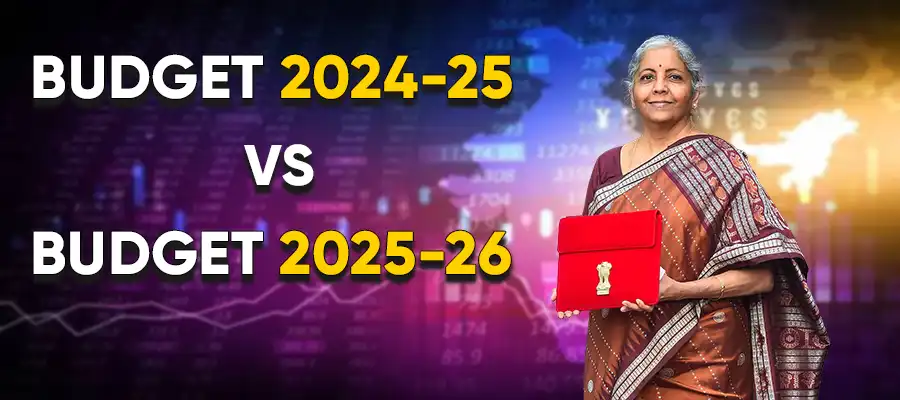The union budget 2025-26, presented by Finance Minister Nirmala Sitaraman has introduced key policy measures aimed at economic growth, fiscal consolidation, and sectoral advancements. This article compares the 2024-25 and 2025-26 budgets, highlighting fiscal policy, taxation, and investment priorities.
The Union Budget 2025 brings significant relief to taxpayers, with the income tax exception limit increased from ₹7 lahks in 2024 to ₹12 lahks (12.75 Lakh for salaried people), providing a substantial boost to disposable income. According to this updated slab in the new regime
Upto 4 lakhs -NIL
- 4 to 4 Lakhs- 5%
- 8 to 12 Lakhs - 10%
- 12 to 16 Lakhs- 15%
- 16 to 20 Lakhs- 20%
- 20 to 24 Lakhs - 25%
- Above 24 Lakhs- 30%
Additionally, the rationalization of TDS and TCS thresholds has lowered excessive deductions, enhancing take-home salaries and easing tax compliance. In healthcare, the exception of life-saving drugs from basic customs duty has been expanded from 20 essential drugs in 2024 to 36 in 2025, significantly reducing medical expenses from 20 essential drugs in 2024 to 36 in 2025, significantly reducing medical expenses. Infrastructure development has also received a major boost, with allocations for interest-free loans to states increasing from ₹1 lakh crore in 2024 to ₹1.5 lakh crore in 2025. The economic growth projection for FY 2025 stands at 6.3%-6.8%, up from 6.1% in 2024, reflecting economic resilience and positive momentum. Moreover, the fiscal deficit has been lowered from 5.1% of GDP in 2024 to 4.8% in 2025, demonstrating improved financial management and fiscal prudence.
Fiscal deficit and borrowing
In the 2024-25 budget, the government prioritized fiscal consolidation, setting the fiscal deficit target at 4.9% of GDP, with a projected reduction below 4.5% for FY 2025-26. Market borrowings were pegged at ₹14 lakh crore, funding 72% of the deficit, with 26% financed through small savings.
The 2025-26 budget furthers this consolidation, targeting a reduced fiscal deficit of 4.4% of GDP. To meet this, the government has planned gross borrowings of ₹14.82 lakh crore and net borrowings of ₹11.54 crore. The total government expenditure is set at ₹50.65 lakh crore, reflecting an increase from ₹47.16 lakh crore in the revised estimates of 2024-25.
Revenue and taxation
The 2024-25 budget introduced revised tax slabs, including an increased standard deduction from ₹50,000 to ₹75,000, easing the burden on salaried taxpayers.
The 2025-26 budget takes this further by providing significant tax relief individuals earning up to ₹12 lakh annually are now exempt from taxes, while higher income brackets benefit from reduced rates. This is expected to cost the exchequer ₹1 lakh crore but is aimed at increasing disposable income and stimulating economic activity. Gross tax revenue is estimated at ₹42.70 lakh crore, while net tax receipts for the Centre are projected at ₹28.37 lakh crore after accounting for state shares. Non-tax revenue is expected at ₹5.83 lakh crore, and capital receipts, including borrowings, are projected at ₹16.45 lakh crore.
Sectoral allocations and infrastructure push
In 2024-25, the government identified nine priorities for inclusive growth, focusing on infrastructure, green energy, and digital innovation. The emphasis on infrastructure remains strong in 2025-26, with capital expenditure set at ₹11.21 lakh crore to accelerate asset creation and development projects. Effective capital expenditure, including grants for capital asset creation, is estimated at ₹15.48 lakh crore.
Transfer to states, covering tax shares, grants, and loans, are projected at ₹25.01 lakh crore, an increase of ₹4.91 lakh crore from 2023-24. The government has allocated ₹12.76 lakh crore for interest payments, making it the largest component of expenditure.
Key sectoral initiatives
-
Agriculture: the government is enhancing support for high-yield crops, increasing subsidies for farm credit, and strengthening procurement policies.
-
Manufacturing & exports: the national manufacturing mission sees renewed focus alongside an increase in the foreign direct investment cap in insurance from 74% to 100%.
-
Social welfare: healthcare benefits under the Pradhan Mantri Jan Arogta Yojana (PM-JAY) are being extended to gig workers, ensuring better coverage for informal sector employees.
-
Digital & green energy initiatives: increased allocations for renewable energy projects and incentives for electric vehicle adoption are key highlights.
Revenue growth and fiscal disciple
The government's fiscal strategy aims to balance growth and discipline, projecting revenue receipts at ₹34.20 lakh crore—an increase from ₹30.88 lakh crore in 2024-25’s revised estimates. The revenue deficit is set at 1.5% of GDP, improving from 1.9% in the previous year, further supporting fiscal prudence.
Altogether the Union Budget 2025-26 builds upon the foundation laid in the previous year, focusing on economic growth, fiscal stability, and inclusive development. By enhancing capital investment, providing tax relief, and promoting sectoral reforms, the budget aims to boost infrastructure, employment, and overall activity. As India continues its growth trajectory, this budget seems to reflect a strategic vision to balance short-term stimulus with long-term fiscal sustainability.
